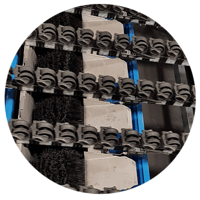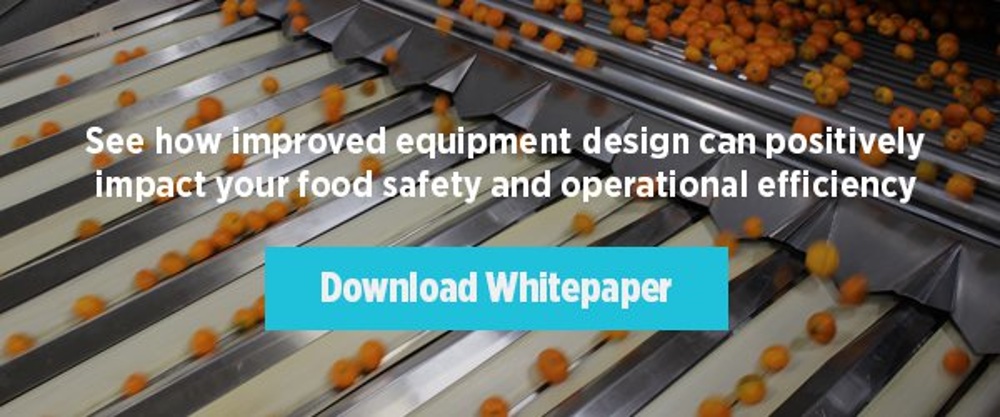
As pressures grow on packhouse managers to improve throughput, yield and output quality simultaneously, the challenge rests on equipment designers to come up with new solutions to these challenges while maintaining or preferably lowering the operational cost.
If it were just a matter of increasing the speed of production, the problem might be easier to solve. But with food safety under increasing scrutiny and subject to more stringent standards than ever, food processing technology could prove the savior – or nemesis – of a business trying to keep up with demand and remain competitive.
The answer lies in an improved and consistent approach to equipment and facility design, that is built around food safety, traceability and productivity from the earliest stages of equipment development and facility design.
Safe food trends and dangers of poor hygienic design
Globalization of the food supply chain is presenting many fantastic opportunities for food producers to expand into international markets.
Yet, as the global markets welcome new products, food safety standards become increasingly strict. And for good reason. A contaminated batch of fresh produce can potentially decimate indigenous crops and pose a threat to public health.
At a business level, this means food producers are moving from trading within their traditional, local market with more lenient food safety regulations, to the global arena. The laws here are very different, set by highly developed countries such as the USA, which has one of the strictest safety standards when it comes to food and drug administration.
 For businesses to compete in these highly regulated markets, food safety is a primary concern. The costs of a single product recall can wipe out an ill-prepared business. Traceability along the entire supply chain is therefore paramount, to minimize the impact of any contamination. Another major challenge is that very developed markets can be very demanding. The consumer expects a consistent quality and supply of their favorite products and if that supply fails, they will quickly move on.
For businesses to compete in these highly regulated markets, food safety is a primary concern. The costs of a single product recall can wipe out an ill-prepared business. Traceability along the entire supply chain is therefore paramount, to minimize the impact of any contamination. Another major challenge is that very developed markets can be very demanding. The consumer expects a consistent quality and supply of their favorite products and if that supply fails, they will quickly move on.
For businesses to compete on the demanding global stage they need to address food safety from a facility level and do everything possible to prevent a contamination from happening at all, while consistently striving to increase output.
Food safety: the importance of sanitization procedures on quality control and productivity
 Fresh produce contaminations are notoriously costly both financially and in terms of reputational damage.
Fresh produce contaminations are notoriously costly both financially and in terms of reputational damage.
These risks can be mitigated by implementing routine food safety and quality checks and implementing advanced sorting technology to remove fruit showing signs of rot or other quality issues.
Some of the most dangerous contaminations, however, occur due to poor sanitization that contributes to microorganic build up on machinery in biofilms. These biofilms are a collection of microbial cells enclosed in an extracellular polymeric substance matrix that can be transferred onto the produce as it passes through the system.
Biofilms are potentially extremely dangerous as they can constitute bacteria, fungus and pathogenic microorganisms that cause serious infections if ingested, as well as affect component lifetime.
Sanitization processes
Contamination will not only have a negative effect on the production cycle but may also cause legal penalties and longer lasting brand damage. It is therefore paramount that every packhouse can conduct efficient and effective sanitization.
There are some key points to consider regarding cleaning efficiency. Firstly, it should be as easy as possible for operators to access all parts of machinery at any possible time. They should be able to perform their duties safely, in a well-practiced routine with consistent results. Machines, such as sorters, should have the flexibility of being cleaned either in place or out of place, to align with each facility’s established food safety plan requirements.
Food safety plans and sanitization as a business-wide programme
 Business expansion means producing more of the quality product the market demands. When international trade is also included, businesses must adhere to potentially much stricter food safety laws and requirements than before.
Business expansion means producing more of the quality product the market demands. When international trade is also included, businesses must adhere to potentially much stricter food safety laws and requirements than before.
Overcoming these challenges is much easier when everyone in your organisation is working towards the same goal.
Key elements of a facility optimised for food safety and sanitization:
- Create a culture of food safety that fosters responsibility for food safety at an individual level
- Equipment infrastructure and component accessibility designs should fully correspond with the regional operator’s regulatory requirements
- Work with your technology partner from the earliest stages of projects to ensure design, equipment and layout meets the specific needs and requirements of your business
- Ensure equipment is designed with hygiene and sanitation as a main characteristic, rather than just the minimum compliance requirement
- Arrange cross-organisational hygienic support, to ensure that guidelines are communicated between suppliers, designers and partners
Improve sanitization and operational efficiency through better equipment design
The hygienic characteristics of processing equipment will become a main requirement by which performance and function is evaluated. On top of construction materials and optimized facility layout, here are the main points to consider:
Visual vs physical accessibility
Operators should be able to visually assess their equipment’s sanitary level without having to physically interact with it, while physical accessibility enables operators to access any part of the sorter in a minimum amount of time.
Sanitation flexibility
Each supplier’s engineers should be fully aware of the sanitization requirements and how to implement these on the design of their equipment and components.
Sorters can then be “designed-to-sanitize” and to be cleaned with different methods depending on the packhouse demands, e.g.: 1) quick clean in place; 2) deeper clean out of place, or even a full wash down in place. This flexibility allows a tailored sanitization plan to be made aligned to the facility’s individual supply chain safety requirements.
Exchangeable components
To enable efficient deep sanitization and maintain equipment availability, ‘high hygiene value’ components from critical areas should be removable and replaceable without tools. This allows for key parts to be removed for cleaning without causing downtime.
Enriched information and user education
Each food processing system should include a detailed Cleaning and Sanitization Manual, to give the user the best possible education with regards to safe sanitization techniques that achieve the best results consistently.
Compliance and lifetime of components
Document recommendations on component lifetimes to ensure continued compliance with global and national standards.
Even when components are compliant, their operational effectiveness and compliance status may be affected by poor sanitization, cleaning products used, the frequency of sanitizing, or the acidic nature of fruit derivatives.



